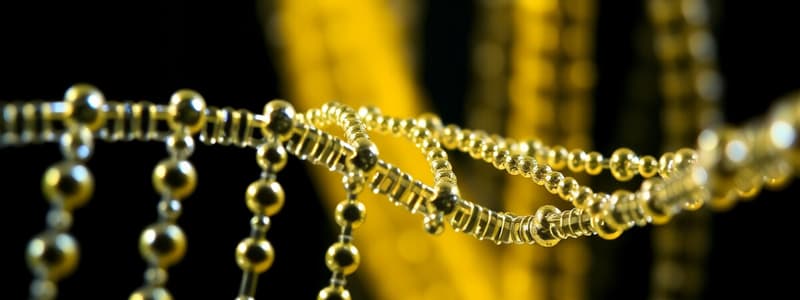Podcast
Questions and Answers
What is Young's modulus of carbon nanotubes (CNTs) within the specified diameter range?
What is Young's modulus of carbon nanotubes (CNTs) within the specified diameter range?
- 2 TPa
- 1 TPa (correct)
- 1.1 – 1.3 TPa
- 0.8 TPa
How much tensile strain can carbon nanotubes sustain before fracture?
How much tensile strain can carbon nanotubes sustain before fracture?
- 5%
- 1%
- 15% (correct)
- 10%
What characteristic of carbon nanotubes contributes to their capability to form sharp U-tubes and loops?
What characteristic of carbon nanotubes contributes to their capability to form sharp U-tubes and loops?
- High thermal conductivity
- High density
- Large diameter
- Extraordinary flexibility (correct)
Which statement accurately describes the relationship between tube chirality and Young's modulus in carbon nanotubes?
Which statement accurately describes the relationship between tube chirality and Young's modulus in carbon nanotubes?
What happens to most hard materials when subjected to strain levels around 1%?
What happens to most hard materials when subjected to strain levels around 1%?
What geometric structure is represented by a single-walled carbon nanotube (SWCNT)?
What geometric structure is represented by a single-walled carbon nanotube (SWCNT)?
What primarily governs the metallic or semiconducting nature of single-walled carbon nanotubes?
What primarily governs the metallic or semiconducting nature of single-walled carbon nanotubes?
Under which condition will a single-walled carbon nanotube be considered metallic?
Under which condition will a single-walled carbon nanotube be considered metallic?
Which bonding type contributes most significantly to the exceptional mechanical properties of carbon nanotubes?
Which bonding type contributes most significantly to the exceptional mechanical properties of carbon nanotubes?
What are Young's modulus and the elastic response to deformation used to characterize?
What are Young's modulus and the elastic response to deformation used to characterize?
What does the chirality of a carbon nanotube determine?
What does the chirality of a carbon nanotube determine?
Which of the following is a property of carbon nanotubes in terms of their mechanical aspect?
Which of the following is a property of carbon nanotubes in terms of their mechanical aspect?
What is true about the relationship between the structural arrangement of bonds in CNTs and their properties?
What is true about the relationship between the structural arrangement of bonds in CNTs and their properties?
What are carbon nanotubes classified as?
What are carbon nanotubes classified as?
Which type of hybridization is present in carbon nanotubes?
Which type of hybridization is present in carbon nanotubes?
Which structure do carbon nanotubes resemble?
Which structure do carbon nanotubes resemble?
How are carbon nanotubes primarily characterized in terms of bonding?
How are carbon nanotubes primarily characterized in terms of bonding?
What is the primary shape of carbon nanotubes?
What is the primary shape of carbon nanotubes?
Which of these materials is NOT considered an allotrope of carbon?
Which of these materials is NOT considered an allotrope of carbon?
In which category do the different types of carbon nanotubes belong?
In which category do the different types of carbon nanotubes belong?
What type of bond is predominantly present in graphite which is similar to that in carbon nanotubes?
What type of bond is predominantly present in graphite which is similar to that in carbon nanotubes?
What happens to methane molecules when the temperature in the chamber is high enough?
What happens to methane molecules when the temperature in the chamber is high enough?
What is the primary source of carbon in the newly developed plasma process for producing nanotubes?
What is the primary source of carbon in the newly developed plasma process for producing nanotubes?
How does the efficiency of the plasma process for producing nanotubes compare to other methods?
How does the efficiency of the plasma process for producing nanotubes compare to other methods?
What part of the carbon nanotubes structure determines their classification?
What part of the carbon nanotubes structure determines their classification?
What is the diameter range of single-walled carbon nanotubes?
What is the diameter range of single-walled carbon nanotubes?
What type of carbon nanotube consists of multiple layers of graphene?
What type of carbon nanotube consists of multiple layers of graphene?
Which statement is true about double-walled carbon nanotubes?
Which statement is true about double-walled carbon nanotubes?
What is the inter-layer distance characteristic of multi-walled carbon nanotubes?
What is the inter-layer distance characteristic of multi-walled carbon nanotubes?
What is the primary reason for the exceptional electronic properties of single-walled carbon nanotubes (SWCNTs)?
What is the primary reason for the exceptional electronic properties of single-walled carbon nanotubes (SWCNTs)?
Which of the following best describes the type of bonds present in carbon nanotubes (CNTs)?
Which of the following best describes the type of bonds present in carbon nanotubes (CNTs)?
How is the mechanical strength of SWCNTs often compared to that of steel?
How is the mechanical strength of SWCNTs often compared to that of steel?
What factors are the electronic properties of SWCNTs dependent on?
What factors are the electronic properties of SWCNTs dependent on?
Which property of carbon nanotubes is NOT mentioned as a characteristic in the content?
Which property of carbon nanotubes is NOT mentioned as a characteristic in the content?
What is a significant characteristic of the structure of carbon nanotubes that contributes to their properties?
What is a significant characteristic of the structure of carbon nanotubes that contributes to their properties?
In which way do the properties of carbon nanotubes correlate with each other?
In which way do the properties of carbon nanotubes correlate with each other?
What type of carbon nanotube structure is specifically referenced in relation to electronic properties?
What type of carbon nanotube structure is specifically referenced in relation to electronic properties?
What distinguishes single-walled carbon nanotubes (SWNT) from multi-walled carbon nanotubes (MWNT)?
What distinguishes single-walled carbon nanotubes (SWNT) from multi-walled carbon nanotubes (MWNT)?
Which statement about the purity of carbon nanotubes is correct?
Which statement about the purity of carbon nanotubes is correct?
In terms of functionalization, how do SWNT and MWNT differ?
In terms of functionalization, how do SWNT and MWNT differ?
What is a primary challenge associated with the bulk synthesis of SWNT?
What is a primary challenge associated with the bulk synthesis of SWNT?
How do SWNT and MWNT differ in terms of their structural flexibility?
How do SWNT and MWNT differ in terms of their structural flexibility?
What is a consequence of MWNT's complex structure?
What is a consequence of MWNT's complex structure?
Which characteristic makes bulk synthesis of MWNT easier compared to SWNT?
Which characteristic makes bulk synthesis of MWNT easier compared to SWNT?
What aspect of SWNT accumulation in the body is notable compared to MWNT?
What aspect of SWNT accumulation in the body is notable compared to MWNT?
Flashcards
SWCNT electronic properties
SWCNT electronic properties
Depend on diameter and helicity (n, m) of the tubes.
SWCNT metallicity
SWCNT metallicity
Determined by chirality (|n-m| multiples of 3).
CNT mechanical properties
CNT mechanical properties
Exceptional due to strong σ bonds and specific geometry.
SWCNT
SWCNT
Signup and view all the flashcards
Chirality
Chirality
Signup and view all the flashcards
σ bonding
σ bonding
Signup and view all the flashcards
Young's modulus
Young's modulus
Signup and view all the flashcards
Elastic response
Elastic response
Signup and view all the flashcards
What are carbon nanotubes?
What are carbon nanotubes?
Signup and view all the flashcards
Allotropes of carbon
Allotropes of carbon
Signup and view all the flashcards
Single-Walled Carbon Nanotubes (SWCNTs)
Single-Walled Carbon Nanotubes (SWCNTs)
Signup and view all the flashcards
Multi-Walled Carbon Nanotubes (MWCNTs)
Multi-Walled Carbon Nanotubes (MWCNTs)
Signup and view all the flashcards
Graphene
Graphene
Signup and view all the flashcards
Carbon nanotube shape
Carbon nanotube shape
Signup and view all the flashcards
Graphite hybridization
Graphite hybridization
Signup and view all the flashcards
Diamond hybridization
Diamond hybridization
Signup and view all the flashcards
Carbon Nanotube Production
Carbon Nanotube Production
Signup and view all the flashcards
Carbon Nanotube Types
Carbon Nanotube Types
Signup and view all the flashcards
Double-Walled Carbon Nanotube (DWCNT)
Double-Walled Carbon Nanotube (DWCNT)
Signup and view all the flashcards
CNT Composition
CNT Composition
Signup and view all the flashcards
Plasma Method Efficiency
Plasma Method Efficiency
Signup and view all the flashcards
Methane and Carbon
Methane and Carbon
Signup and view all the flashcards
Catalyst Requirement
Catalyst Requirement
Signup and view all the flashcards
Bulk Synthesis Difficulty
Bulk Synthesis Difficulty
Signup and view all the flashcards
Purity Comparison
Purity Comparison
Signup and view all the flashcards
Defect Occurrence
Defect Occurrence
Signup and view all the flashcards
Body Accumulation
Body Accumulation
Signup and view all the flashcards
Characterisation and Evaluation
Characterisation and Evaluation
Signup and view all the flashcards
CNT Flexibility
CNT Flexibility
Signup and view all the flashcards
CNT Strength
CNT Strength
Signup and view all the flashcards
Why are CNTs so strong?
Why are CNTs so strong?
Signup and view all the flashcards
Young's Modulus of CNTs
Young's Modulus of CNTs
Signup and view all the flashcards
Multi-walled CNT Young's Modulus
Multi-walled CNT Young's Modulus
Signup and view all the flashcards
What makes CNTs unique?
What makes CNTs unique?
Signup and view all the flashcards
CNT properties dependence
CNT properties dependence
Signup and view all the flashcards
Strong chemical bonding in CNTs
Strong chemical bonding in CNTs
Signup and view all the flashcards
SWCNTs mechanical strength
SWCNTs mechanical strength
Signup and view all the flashcards
What are (n, m) indices?
What are (n, m) indices?
Signup and view all the flashcards
Graphene sheet and CNTs
Graphene sheet and CNTs
Signup and view all the flashcards
Why are CNTs so good?
Why are CNTs so good?
Signup and view all the flashcards
Study Notes
Carbon Nanotubes
- Carbon nanotubes (CNTs) are allotropes of carbon, like diamond, graphite, and fullerenes.
- CNTs are tubular in shape, made of graphite.
- Outer diameter ranges from 3 nm to 30 nm.
- There are single-walled, double-walled, and multi-walled CNTs.
Classification of Carbon Nanotubes
- Single-walled CNTs (SWNTs): Composed of a single graphene sheet rolled up upon itself.
- Multi-walled CNTs (MWNTs): Consists of multiple layers of graphene rolled upon itself, with diameters ranging from 2 to 50 nm.
- Double-walled CNTs (DWNTs): Composed of two concentric carbon nanotubes, with the outer tube enclosing the inner tube.
- Classification based on chirality: armchair, zigzag, and chiral. Chirality is determined by the chiral vector C(n,m) obtained from the arrangement of graphite hexagons.
Properties of Carbon Nanotubes
- Electronic: Properties depend on the diameter and helicity of the tubes (n,m indices)
- Some SWCNTs are metallic, while others are semiconducting.
- Mechanical: High tensile strength (1-1.3 TPa) and stiffness (high Young's modulus) due to strong chemical bonding.
- Thermal: High thermal conductivity (6600 W/mK) and thermal stability.
Methods of Synthesis of Carbon Nanotubes
- High-pressure carbon monoxide deposition (HIPCO): Uses a carbon monoxide gas and iron atoms, forming carbon dioxide and initiating nanotube formation.
- Chemical vapor deposition (CVD): Uses a hydrocarbon gas (e.g., methane) in a heated chamber with a catalyst (e.g., iron). Breaks bonds in the carbon and hydrogen, allowing carbon atoms to attach to the catalyst, forming nanotubes.
- Plasma-enhanced CVD: Uses plasma to enhance these processes. A new method that is more efficient.
Applications of Carbon Nanotubes
- Energy storage (capacitors, batteries, fuel cells).
- Electronics (transistors, wires) - High current density, high electron mobility, high thermal conductivity.
- Materials (reinforcements, composites) - lightweight, high physical strength, high electronic conductivity, high wear resistance.
- Biotechnology (biosensors, drug delivery systems, cell cultivation).
Additional Notes:
- There are also variations and classifications like Russian Doll and Parchment models
- Different types and classifications determine their unique physical properties
- There are various methods to increase purity and produce different types of CNTs.
Studying That Suits You
Use AI to generate personalized quizzes and flashcards to suit your learning preferences.




